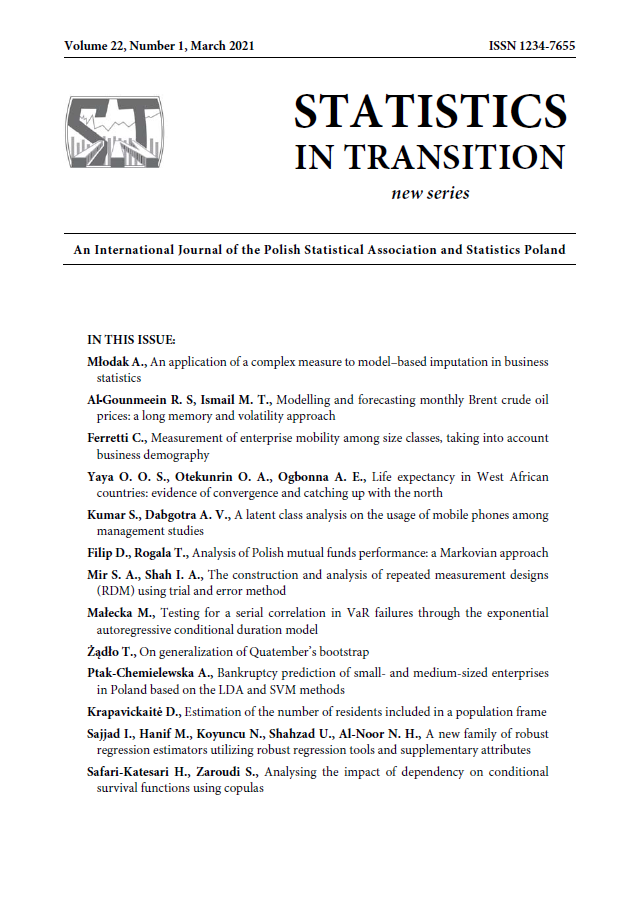ARTICLE
ABSTRACT
A extensive body of literature is devoted to the production of mobility measures based on transition matrices. The applications often involve panel data, and yet the impact of demographic events on enterprise mobility is not considered. The article aims provide a definition of enterprise mobility, in terms of the capability to create or liquidate jobs. Moreover, some existing mobility measures are modified so that they also take into account newborn and exiting firms. The proposed index has all the relevant basic properties which make it a rigorous descriptive statistics. The mobility of Italian capital-owned enterprises in the years 2010 – 2017 is analysed in the case study.
What we propose may be an alternative tool for practitioners to measure the degree of mobility in the presence of demographic events. It may be considered an initial step in future research regarding its different applications (e.g. labour market flows or movements among income classes), also considering more complex theoretical backgrounds.
KEYWORDS
mobility measure; transition matrix; firm size; business demography
REFERENCES
ADELMAN, I., (1958). A stochastic analysis of the size distribution of firms. J Am Stat Ass, 53(284), pp. 893–904.
BARTHOLOMEW, D. J., (1982). Stochastic Models for Social Processes, 3rd ed. London, Wiley.
BOURGUIGNON, F., MORRISSON, C., (2002). Inequality among World Citizens. Am Econ Rev, 92(4), pp. 727–744.
EUROSTAT BUSINESS DEMOGRAPHY, retrieved from https:// ec.europa.eu/eurostat/web/structural-business-statistics/business-demography, accessed May, 18, 2020.
CHEN, Y., COWELL F., (2017). Mobility in China. Rev Income Wealth, 63, pp. 203–218.
COWELL, F., FLACHAIRE E., (2018) Measuring Mobility. Quant Econ, 9, pp. 865–901.
DUNCAN G., LIN L., (1972). Inference for Markov chains having stochastic entry and exit. J Am Stat Ass, 67(340), pp. 761–767.
EUROSTAT – OECD, (2007). Manual on Business Demography Statistics, Luxembourg: Office for Official Publications of the European Communities, ISBN: 978-92-79-04726- 8.
FERRETTI, C., (2012). Mobility as prevailing direction for transition matrices. Stat Appl, 10(1), pp. 67–79 .
FERRETTI, C., (2014). Sampling properties of the directional mobility index and the income of Italian families. Statistica, 4, pp. 455–466.
FERRETTI, C., GANUGI, P., (2013). A new mobility index for transition matrices. Stat Method Appl, 22(3), pp. 403–425.
FERRETTI, C., GABBI, G., GANUGI, P., SIST, F., VOZZELLA, P., (2019). Credit Risk Migration and Economic Cycles. Risks, 7(109), pp. 1–18.
FIELDS, G., OK, E., (1996). The Meaning and Measurement of Income Mobility. J Econ Th, 71(2), pp. 349–377.
FORMBY, J.P., SMITH, W.J., ZHENG, B., (2004). Mobility measurement, transition matrices and statistical inference. J Econometrics, 120, pp. 181–205.
GEWEKE, J., MARSHALL, R., ZARKIN, G., (1986). Mobility Indices in Continuous Time Markov Chains. Econometrica, 54(6), pp. 1407–1423.
GOMES, P., (2012). Labour Market Flows: Facts from the United Kingdom. Labour Economics, 19(2), pp. 165–175.
ISTAT, (2016). Demografia d’impresa 2009–2014. Tech. rep., Centro diffusione dati.
ISTAT, (2019). Demografia d’impresa 2012–2017. Tech. rep., Centro diffusione dati.
IL SOLE 24 ORE, 26th March 2013, https://st.ilsole24ore.com/art/notizie/2013-03- 26/italia-paese-colpito-crisi-123024.shtml#comments.
JAFRY, Y., SCHUERMANN, T., (2004). Measurement, estimation and comparison of credit migration matrices. J Bank Financ, 28(11), pp. 2603–2639.
MACCHIARELLI, C.,WARD-WARMENDINGER, M., (2014). Transitions in labour market status in EU labour markets. IZA J Eur Labour Stud, 3(1), pp. 1–17.
PAUL, S., (2019). A measure of Income Mobility based on Transition Matrices and application to China and the United States. J Asia Pacific Econ., 25(3), pp. 389–401.
PRAIS, S. J., (1955). Measuring social mobility. J Roy Stat Soc, Series A, part I, 188, pp. 56–66.
SHOEN, R. (1988). Practical uses of Multistate Population Models. Ann Rev Sociol, 14, pp. 341–361.
SCHLUTER, C., (1998). Statistical inference with mobility indices. Econ Lett, 59, pp. 157– 162.
SHORROCKS, A., (1978). The measurement of Mobility. Econometrica, 46(5), pp. 1013 – 1024.
SHORROCKS, A., (1982). On the distance between income distributions [inequality measures between income distributions with applications]. Econometrica 50(5), pp. 1337– 1339.
VIOLI, R., (2008). Credit Ratings Transition in Structured Finance. J Financ Transf, 22, pp. 1–36.
